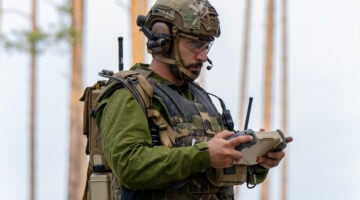
WASHINGTON: The Air Force is backing off on its 2023 goal to transition the AI-driven Skyborg drone experiments to a formal procurement program, with one of Skyborg’s lead officers today citing the need for considerable budgetary tradeoffs.
“I don’t know that I would commit to a timeline of when it will be a program of record,” Brig. Gen. Dale White told reporters today.
White, who is the program executive officer (PEO) for fighters and advanced aircraft at the Air Force Life Cycle Management Center, explained that the issue isn’t actually reaching desired capability by 2023. Instead, it’s about money.
“I won’t say that it’s not achievable,” he said. “I will just say that it has to be balanced with all of the other requirements we have across the portfolio to be able to do that. And I think there’s still some amount of work that we want to do with respect to both the platform and the autonomy piece before we make that transition, and so we’re on the path to that.
“I will tell you I think if we, if the Air Force, thought that it fit inside future budgets, certainly I think we’d be ready. I just don’t think we’re ready to commit to that right now”
Nonetheless, the capabilities being developed under Skyborg are “going to be a key part of the future,” he said. “We’ll work with the department to figure out how this fits into the overall picture of the force structure in the long term.”
Skyborg is one the Air Force’s high-priority Vanguard programs, designed to rapidly move capabilities from the lab to the field. The Vanguards are structured around operational experiments in a manner that somewhat blurs the line between research & development and procurement — with the Air Force Research Laboratory and AFLCMC PEOs partnering on each one.
The program is aimed at proving out capabilities for teaming autonomous drones with piloted aircraft for a number of missions, including those in which losing a pilot and an expensive fighter jet are highly likely. Skyborg comprises three separate but inter-linked efforts: the low-cost drone, the artificial intelligence algorithms making up the Autonomous Core System (ACS) “brain,” and the ongoing experiment campaign called the Autonomous Attritable Aircraft Experimentation (AAAx) tests. The Air Force asked for $58.6 million in its fiscal 2022 budget request for Skyborg, with work next year expected to concentrate on further development of the ACS.
The service last December announced 24-month contracts for three Skyborg competitors: Boeing, for $25.7 million; General Atomics Aeronautical Systems Inc., for $14.3 million; and Kratos Unmanned Aerial Systems Inc., for $37.8 million. Those prototypes will need to be able to integrate with the ACS, designed by Leidos, serving as Skyborg System Design Agent.
The ACS successfully flew a General Atomics MQ-20 Avenger on June 24, marking the second time the software package has piloted a drone — and proving that it can be integrated into different drones.
The first flight of the Skyborg ACS took place April 29 aboard a Kratos UTAP-22 Mako. Kratos actually is competing two drone types in Skyborg, the other being the larger XQ-58A Valkyrie. Valkyrie, in a Dec. 9 test carried the Air Force’s gatewayONE software translation system to connect the incompatible machine languages of the F-35 and F-22 fighter jets.
Next up will be a flight on Boeing’s Airpower Teaming System (ATS) combat drone, originally developed for Australia. White said that while he didn’t know the exact date for that flight test, he was expecting it to take place “later” next year — with the Air Force and Boeing currently working on making modifications to accommodate the drone at US test ranges.

